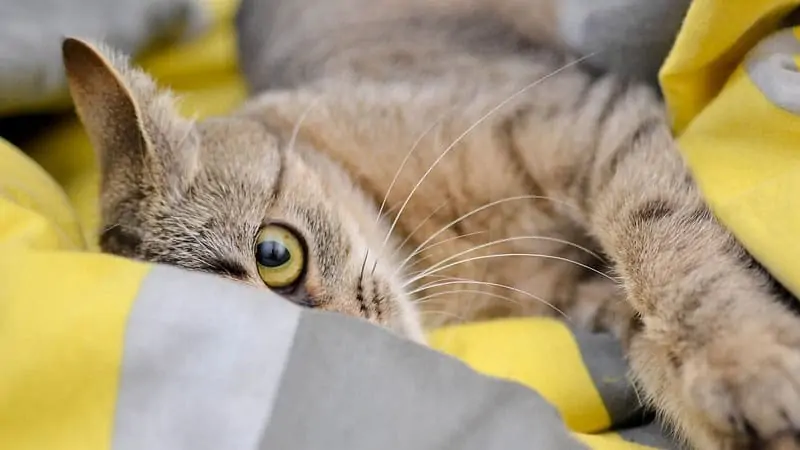Cats love their freedom and may not react well to long drives. On a 24-hour drive, you may experience incessant meowing, clawing, and attempts to jump out an open window. Nonetheless, with adequate preparation, a long road trip can be exciting for both you and your cat.
You can go on a 24-hour drive with your cat. You will need to put in place safety precautions, proper identification, food and water, litter, and some toys to keep your cat calm and engaged. Pheromone scents could also make for an easier and more pleasant ride.
One of the most important rules of driving long distances with a cat is to secure the cat. Even the most well-behaved feline can get restless if loose inside the car. This article offers a complete guide on what to do and not to do when going for a 24-hour long drive with your cat.
Can You Drive Long Distances with Cats?

You can drive long distances with a cat. Cats can be very lively and exciting traveling companions. To make the trip safe and pleasant, you’ll have to make the following preparations:
Vet Visit
When considering traveling long distances with your cat, first pay a visit to your vet. Get up to date with all vaccinations, especially rabies. Ask your vet about any concerns. Ask about any nausea and anxiety medications your cat may need.
Trial Run
Is your cat used to riding in the car? If not, then start getting her used to riding with you long before the long drive.
Start with short trips to places the cat would find exciting. You want the cat to associate car trips with positive experiences. Gradually increase the time and distance you cover, even if you just drive around the block for a while.
Food and Water
Pack enough food and water to last longer than the trip. There might be delays along the way. You may also not find time to go for supplies when you’re settling in your new destination. If possible, portion out the feeds as you may not have time or space during the trip.
Carry water from home as cats can be picky about the water they drink. Give your cat some water at every stop along the way to ensure it remains hydrated.
Carrier
A free-roaming cat in a moving vehicle is a potential projectile in case you hit your emergency brakes. Additionally, the cat could be a distraction and may even attempt to jump out of a moving car. The best way to secure the cat is to use a carrier.
For a long 24-hour drive, you need a high-quality carrier. Your carrier should be:
- Strong
- Well-ventilated
- Ample-sized
- Comfortable
Identification
It’s always prudent to have clear identification on your cat. The two most important forms of identification are a well-labeled collar and a microchip. On your vet visit check whether the microchip still works and hasn’t migrated. Sometimes the microchip moves from the shoulder blades to the belly or rear leg and won’t work as well. Also, when the microchip migrates it may become painful to your cat during long bumpy rides.
For the collar, you want one with a clear name tag. A breakaway cat collar would be best as it protects the cat from getting stuck or choking itself. This is especially important if by some bad luck you get involved in a road accident. The name tag should include your:
- Home address
- Destination address
- Telephone number
- Emergency phone number
- A phrase like “I’m microchipped” or “I’m lost. Please call Susan/Ken on 0987-654-321”
Calm The Cat

Bring along some toys to help your cat stay calm and positively engaged. Puzzle toys are a great way to add some mental stimulation to your journey and keep the cat distracted.
Another way to help your cat feel secure is to spray some synthetic pheromones. Humans can’t smell it so it won’t stink up your car. Most cats will respond well to synthetic pheromones while others seem not to notice.
Carry some anxiety medications for your cat. However, only administer the medication if your cat shows signs of extreme stress and unease. Anxiolytics can work great to calm anxiety. Anti-nausea medications can help stall vomiting, especially in the earlier phases of the road trip.
Heavy clothing such as blankets and towels from home can also help keep the cat feeling calm. Choose clothing that the cat’s favorite person wears often. You may also mix up clothing items from more than one family member.
How Long Can You Drive with A Cat in The Car?
Cats are often comfortable staying inside carriers for up to 8 hours. However, others may need a break every two or three hours.
The length of time you can drive with your cat in the car largely varies on the cat and its age. Stopping every two to four hours allows your cat to stretch its muscles, breathe in some fresh air, relieve itself, and enjoy some quiet time away from the engine’s hum.
Whenever you make rest stops, don’t leave your cat behind. If you can’t walk the cat, carry it in its crate.
Even with the windows cracked, leaving a cat alone in the car can be dangerous. On sunny days, the inside of a car can get to 105 degrees Fahrenheit (40 degrees Celsius) in less than ten minutes. You don’t want to come back to a cat that’s dehydrated or developed heatstroke.
How Do You Transport a Cat Long Distance in A Car?
To transport your cat long distance in a car:
- Start with a visit to your vet. Check the microchip, update vaccinations, and get qualified advice with regard to your destination and route.
- Get all necessary supplies such as cat food and water. Cats can be picky about the food and water they drink. Carry what they normally eat and drink at home.
- Ensure your cat’s identification is intact. The cat’s microchip, the collar, and the name tag should all make it easier to find your cat if lost.
- Get a carrier. It has to be strong and spacious. Cushion it with some clothing from home. Spray with synthetic pheromone and add some of your cat’s favorite toys.
- Take breaks every two to four hours along the drive. Take the cat out of the carrier and walk them on a leash. Be careful as the cat can easily escape and get lost.

